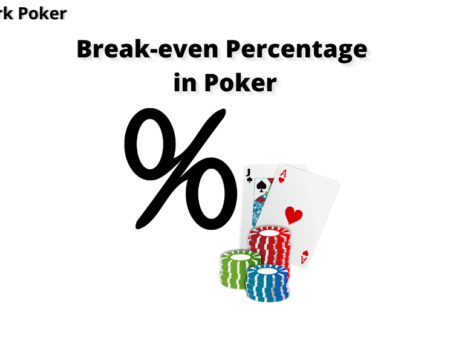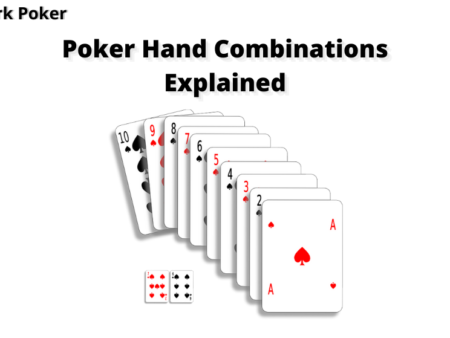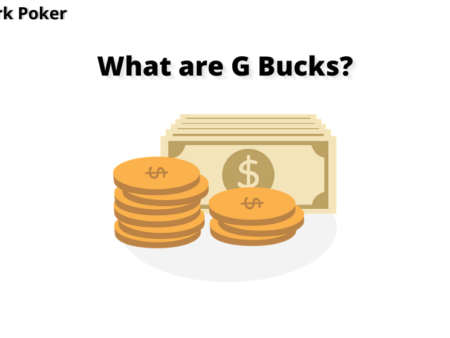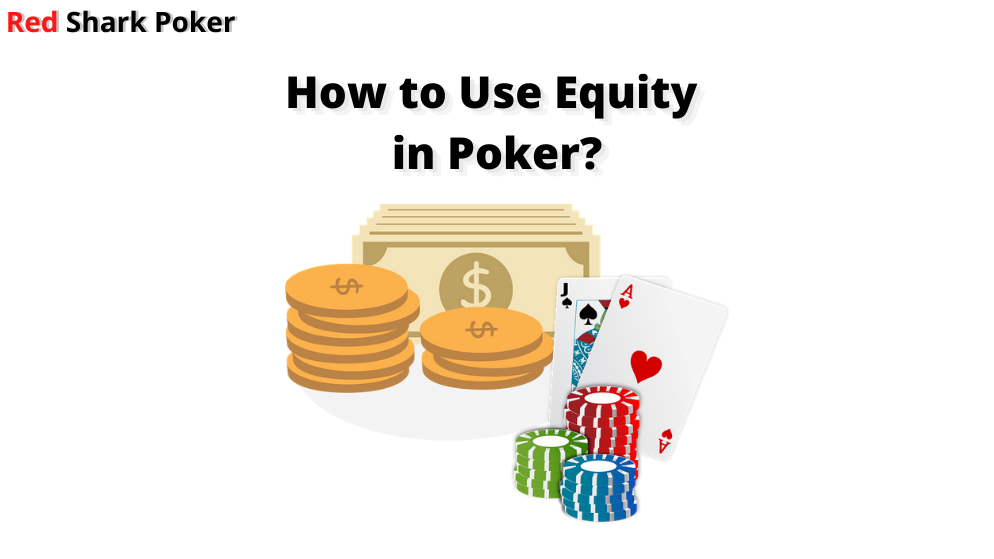
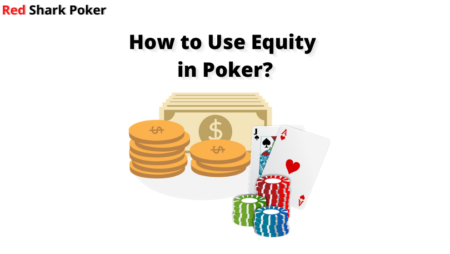
Equity in the business world refers to the amount of capital invested or owned by a company’s shareholders. It represents the amount of money that would be returned to the shareholders if all the assets are liquidated. In poker, you can define equity as your share of the pot, which you have invested from the preflop. It tells you what’s your share of the pot based on your chances of winning.
This would be a simple definition of poker equity, but it has a far deeper meaning and usage in the game. Let us understand the concept in detail.
What is Equity in Poker?
Equity, also known as pot equity, is the rightful share of the pot that belongs to you based on the chances of winning the hand at the current point in the play. Thus, equity changes on the preflop, flop, turn and river.
Let’s look at an example: You are up against a single opponent on the flop. If the pot on the flop is $200 and you have a 50% chance of winning the hand, your equity is $100.
Pot = $200
Chances of Winning = 50%
Equity = Share of the pot based on the chances of winning
= 50% of the pot
= 50% of $200
= $100
So, you have $100 equity based on the 50% chance of winning the hand on the flop. This does not mean that you will win $100 out of $200 right away. Only one of the two players will win the entire pot depending on the cards that will hit on the turn and river or who forces the other player to fold with a bet or a raise.
We usually use the term equity in terms of the percentage of the time you would win a hand. You can say that “equity” is a fancy word used for your winning percentage. For example, when you say pocket aces (AA) have 81% equity over another pair on the preflop, you are saying that you have an 81% winning chance on the preflop with pocket aces. If you specifically want to talk about pot equity, then your pocket aces will have $81 equity in a pot of $100.
How to Calculate Poker Equity?
There are many ways to calculate the equity of your hand in poker. Also, there are free online poker equity calculators to find out the equity of your hand against a specific hand or a range of hands. Let’s look at the popular ways of finding poker equity.
1) Rule of 4 and 2 (or 2 and 4)
This is the easiest and most common way of calculating poker equity. The rule of 4 and 2 is a post-flop method where you can calculate your hand equity on the flop and turn. In order to use this method, you need to find your outs first. If you don’t know how to calculate outs, you can click here: How to Calculate Outs in Poker
The Rule of 4 and 2 states:
Equity on the Flop waiting for the Turn = Number of Outs X 4
Equity on the Turn waiting for the River = Number of Outs X 2
It’s that simple! Let’s look at an example to calculate the poker equity using the rule of 4 and 2.
Your Hand: 3♦ 4♦
Flop: 8♦ K♣ 2♦
We have a flush draw with 9 outs. So, when we are on the flop waiting for the turn, we have 36% equity.
Equity on the Flop = 9 outs x 4
= 36%
Turn: 8♦ K♣ 2♦ 10♠
We still have a flush draw with 9 outs. So, when we are on the turn waiting for the river, we have 18% equity.
Equity on the Turn = 9 outs x 2
= 18%
2) Poker Equity Calculator
There are many free and paid software available online to calculate poker equity. One of the free and best software is Poker Strategy’s Equilab. You can click here to download the free poker equity calculator: Equilab Poker Equity Calculator
You can add a specific hand that you think that your opponent is holding or add his range of cards. Then add your hole cards. You can also add the community cards on the flop, turn and river to calculate the equity.
Your Hand vs A Specific Hand
You hold pocket kings and a very tight player goes all-in preflop. You strongly assume that he holds pocket aces. Now calculate the equity of pocket kings against pocket aces.
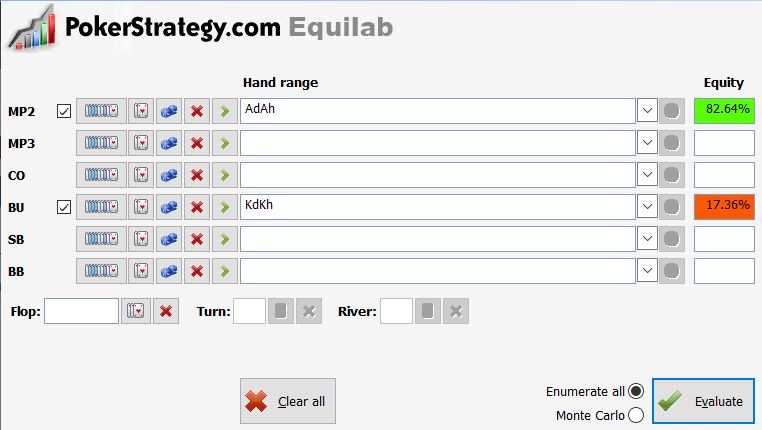
You can see that your hand (pocket kings) has only 17.36% equity against pocket aces. So, it is better to fold.
Your Hand vs a Range of Hands
It is very difficult to pinpoint the exact hand of your opponent. So, you always think of the range of hands your opponent might be holding. For example, you hold 8♦ 9♦, and your opponent raises to five times the big blind. Based on the previous experience with your opponent, you know that he raises with only broadway hands (10s to Aces) + pocket sixes and above. If you feed your hand and your opponent’s range into Equilab, you find that you have 36.64% equity.
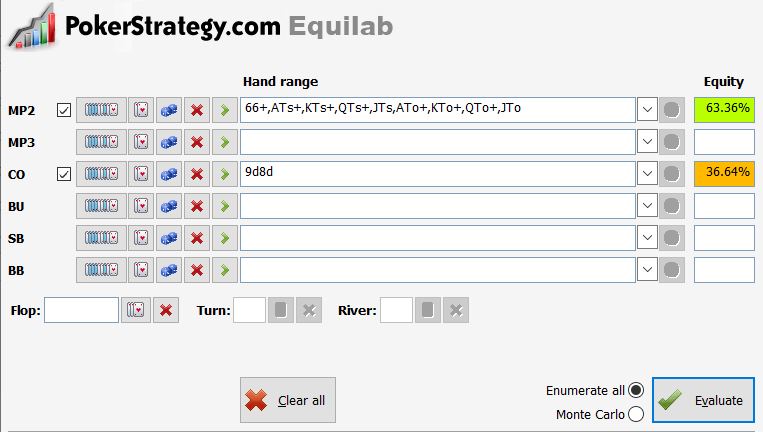
You decide to call, and the flop comes Q♦ 5♦ 3♠. If you enter the flop cards, you see that your hand has 44.48% equity.
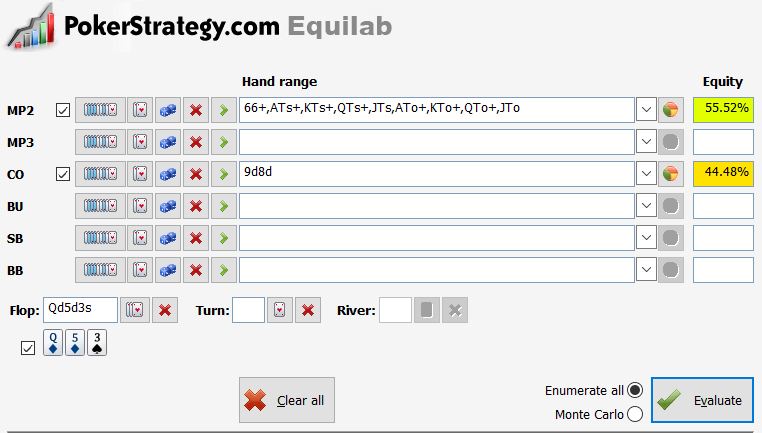
You decide to call, and the turn comes Q♦ 5♦ 3♠ 2♣. If you enter the turn card, you see that your hand has 26.88% equity.
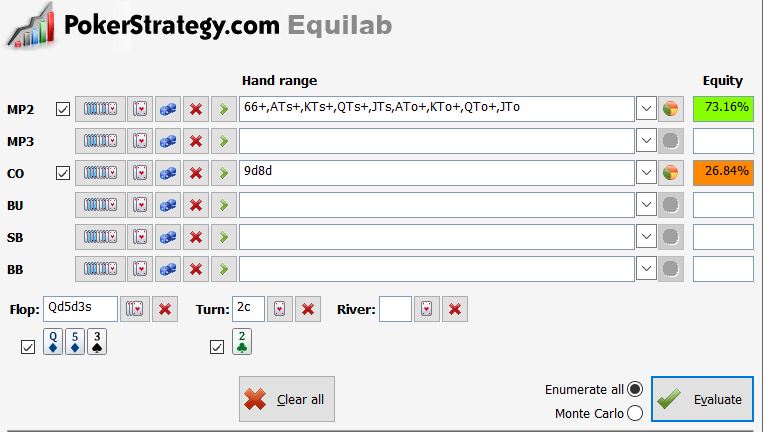
As you can see, poker equity chances on every street. So, it is better to keep track of your equity against your opponent’s range on every street.
There are many paid poker equity calculators that you can purchase, like Flopzilla, Poker Ranger, Poker Cruncher, etc. Such paid software offer more insight into your opponent’s range. For example, if we feed the above cards into Flopzilla, we can get more insights. It will show the percentage of your opponent hitting a top pair, gutshot, overcards, etc.
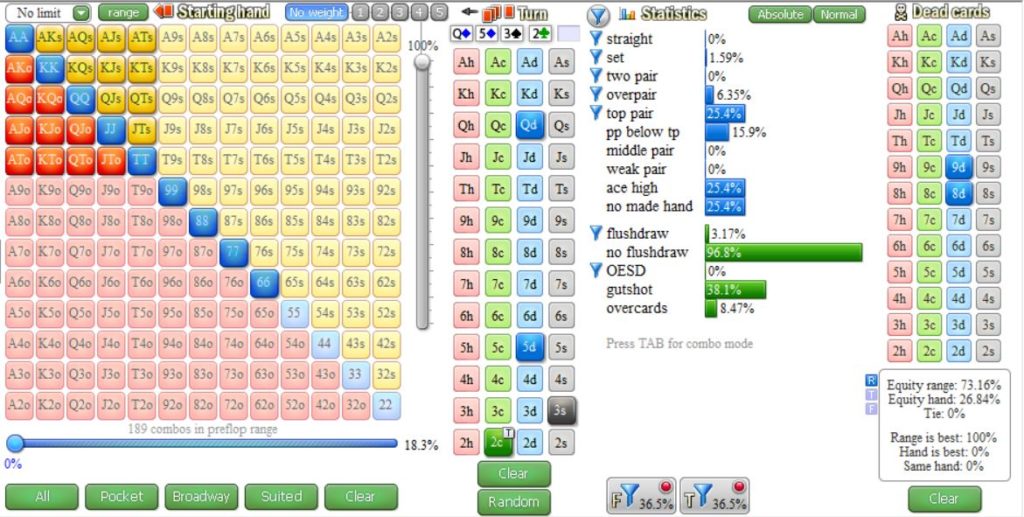
How to Use Equity in Your Game?
Now, the most important question is – what do you do with poker equity? Let’s see how to use equity while playing poker.
Value Bet with High Poker Equity
If you have more than 50% equity in your hand, try to extract maximum value from your opponent. If you are using a poker equity calculator and see that you have higher equity than your opponent’s range of hands, you should bet for maximum value. For example, your hand Q♥ Q♠ has 90.89% equity over your opponent’s range (Broadway hands + 66 & above) on a board of A♦ 7♠ Q♥. Unless your opponent holds pocket Aces, which you can guess from his preflop action, you have the best hand with a set of Queens. With 91% equity, for every dollar you bet, you will be winning 91 cents. So, never miss out on value if you have high poker equity.
Compare Equity with Pot Odds on Drawing Hands
Whenever you have a drawing hand, always compare your equity in hand with the pot odds. The golden rule is: Equity should be greater than the Pot Odds. When the equity is greater than the pot odds, calling your opponent’s bet will be profitable in the long run. If you don’t know how to calculate pot odds, click here: How to Calculate Pot Odds in Poker. Let’s review the previous example with pot odds:
Your Hand: 8♦ 9♦
Opponent’s Range: Broadways (ATs+,KTs+,QTs+,JTs,ATo+,KTo+,QTo+,JTo) and Pocket Sixes and above (66+)
Preflop
You are on the Button in a $1/$2 6-max game. The Under the Gun (UTG) bets $2. The Middle Position (MP) raises to $5.
Pot Odds: 33% (Call/Final Pot)
Equity: 36.64% (Calculated Above)
Your equity is greater than the pot odds. So, you can call here.
Flop: Q♦ 5♦ 3♠
On the flop, the MP makes a half-size pot bet of $7.5 into a pot of $15.
Pot Odds: 25% (Call/Final Pot)
Equity: 44.48% (Calculated Above)
You have good equity over the pot odds. Here, you can choose to raise and semi-bluff. However, you haven’t made your hand and suspect that your opponent has a pair of queens as a Queen is well within his range. You know that he is a sticky player; so, even if you raise, he is not likely to fold. You decide to just call.
Turn: Q♦ 5♦ 3♠ 2♣
On the flop, the MP makes a pot-size bet of $22.5 into a pot of $22.5.
Pot Odds: 33% (Call/Final Pot)
Equity: 26.84% (Calculated Above)
Your equity has dropped significantly. Pot odds are now greater than your equity. With the increase in the bet size, you can suspect that he is either trying to protect his pair of queens as the board looks dangerous. As he is a sticky player, who never folds if he catches any part of the board, bluffing here won’t work. You may choose to semi-bluff, but you have insufficient equity to continue. As the pot odds are greater than your equity, you will be losing more in the long run. So, you should fold.
In case you want to call, you should check your implied odds to see how much money you need to win on the river if you complete your flush. If the implied odds seem ok, you might call. If you don’t know how to calculate implied odds, click here: How to Calculate Implied Odds
Implied Odds = [(1/Equity) X Call Amount] – (Total Pot + Call Amount)
= [(1/0.27) X 22.5] – (45 + 22.5)
= (3.7 X 22.5) – 67.5
= 83.25 – 67.5
= 15.5
As you can see, you don’t expect to win much on the river even if you complete your draw. You will get a small reward for the bigger risk you took. So, folding here will be the best option.
Conclusion
Always calculate your hand equity before taking any step. It is a lot easier to calculate your equity in online poker by using any free or paid software. You can keep a different window on your computer that has an online equity calculator and switch to the tab while playing. Remember, poker equity changes on every street. An 80% equity can drop to 30% on the next street. So, always keep track of your equity to make an informed decision. If you have high equity, try to extract maximum value. And, if you have a drawing hand, your equity should be greater than the pot odds. A good understanding of equity and the right application of poker strategies will always make you a winning player in the long run!

